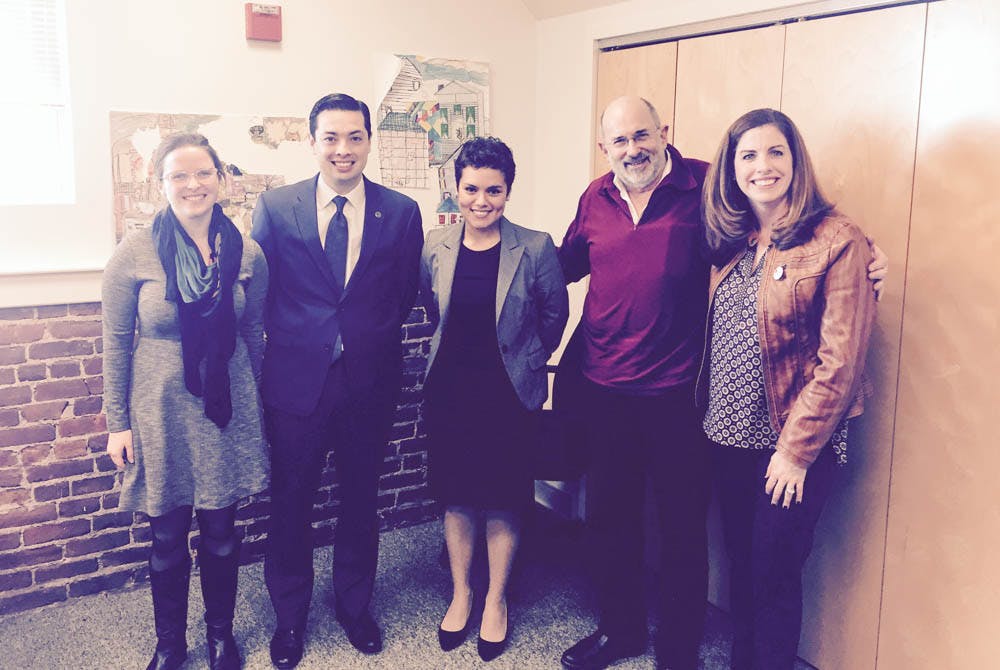Two days each month, children at Calcutt Middle School in Central Falls receive a special visit from Warren Alpert Medical School students.
The medical students come to Calcutt to teach a class that can be uncomfortable for students and teachers alike: sexual education. They wear scrubs emblazoned with their organization’s logo: “Sex Ed by Brown Med.”
The group conducts its lessons in Central Falls, where the public school system has struggled to teach its students about sexual health, said Naomi Adjei MD’17, the program’s principal founder.
Effective sex education is important in Central Falls, which “has the highest rates of teen pregnancy in the state” — three times the national average, Adjei said. Before Sex Ed by Brown Med arrived, “physical education teachers would touch on the topic,” but sexual education “wasn’t a comprehensive unit,” she said.
The program was started by a group of five students from the Alpert Medical School with support from Susanna Magee, clinical associate professor of family medicine.
After Magee delivered a lecture about teen pregnancy in Rhode Island, students approached her to discuss starting a sexual education program in Central Falls. Four of the five founding members had prior teaching experience from the program Teach for America, said Kunal Sindhu MD’17, co-founder of Sex Ed by Brown Med. They used that experience to design a sexual education curriculum during summer 2014.
The team used existing curricula as a starting point when building their own, said Michael Yacovelli MD’17, a co-founder. Looking at nationally recognized sexual education systems, the program leaders went through a list of “foundational things that every middle school student should know,” Yacovelli said. They ended up with seven lessons covering a range of topics, including sexually transmitted diseases, contraceptives, gender identity and sexual orientation.
The founders recruited classmates, and after gaining permission from Central Falls authorities they began teaching at Calcutt Middle School during the 2014–15 academic year. The program continues to this day and has expanded steadily in the past years. “Last year, when I first got on the (executive board), we had 12 classrooms,” said Kristen Durbin MD’19, a former member of the e-board. “This year we had 13 classrooms” with 26 to 28 medical students at every lesson.
Before Sex Ed by Brown Med came to Calcutt, “sex ed was taught to whole classrooms of up to 40 students at a time,” wrote Sarah Bourne MD’20, a current member of the e-board, in an email to The Herald, adding that the current student-to-teacher ratio is 6-to-1.
The curriculum has since grown from seven lessons to 12, with each e-board continuing to improve the program, Durbin said. The team also consulted the Center for Sexual Pleasure and Health in Pawtucket for advice on their gender identity and sexual orientation lesson.
Sex Ed by Brown Med also participates in community outreach, such as leading workshops with parents, said Erica Duh MD’18, a former member of the e-board. Because Central Falls has a large Hispanic population, the medical students also “started printing out worksheets (in Spanish) … for the Spanish-speaking students,” Duh said.
In the classroom, the medical students approach teen pregnancy with sensitivity as it is “almost the norm” there, Adjei said. To make an impression, the educators invited high school students who were already mothers to talk to the students. “We thought that resonated more with the middle schoolers” than simply lecturing at them, Adjei added.
Using data from Sex Ed by Brown Med’s first year teaching at Calcutt, the team published their findings in the Rhode Island Medical Journal January. They saw a five percent increase in the sexual health knowledge of their middle school students, measured by tests taken before and after the lessons. This number may seem small, but the program is effective when “looking at individual students,” Adjei said. The students with the lowest pre-test scores often improved the most.
Additionally, only 16.7 percent of medical students were uncomfortable discussing the sexual education topics, compared to 60 percent of Calcutt teachers, according to the article. Data showed that after the program ended, students were also more comfortable talking about sex with adults and believed sexual education was more important, Adjei added.
The team’s success at Calcutt comes from tailoring the curriculum to the students’ needs, Adjei said. But this strategy would be difficult to replicate on a larger scale, she added.
“When we started, we had really big dreams,” said Dorothy Liu MD’17, a co-founder of the program. “We were hoping that this would be a national initiative — that was our … lofty goal.”
The work the medical students have put into this program has not gone unappreciated. “The teachers express gratitude for our help, the students are curious and engaged during our lessons, and families rarely choose to opt their child out of our classes,” Bourne said.
“I am so proud of all the hard work and dedication of this project. (Sex Ed by Brown Med) is a game changer for the adolescents of Central Falls,” wrote Karin Luther, a teacher at Calcutt involved in the program, in an email to The Herald. “This sensitive and crucial topic is of utmost importance and can have lasting impact on the health of the individual and our community. This program should be the model for all middle schools.”





